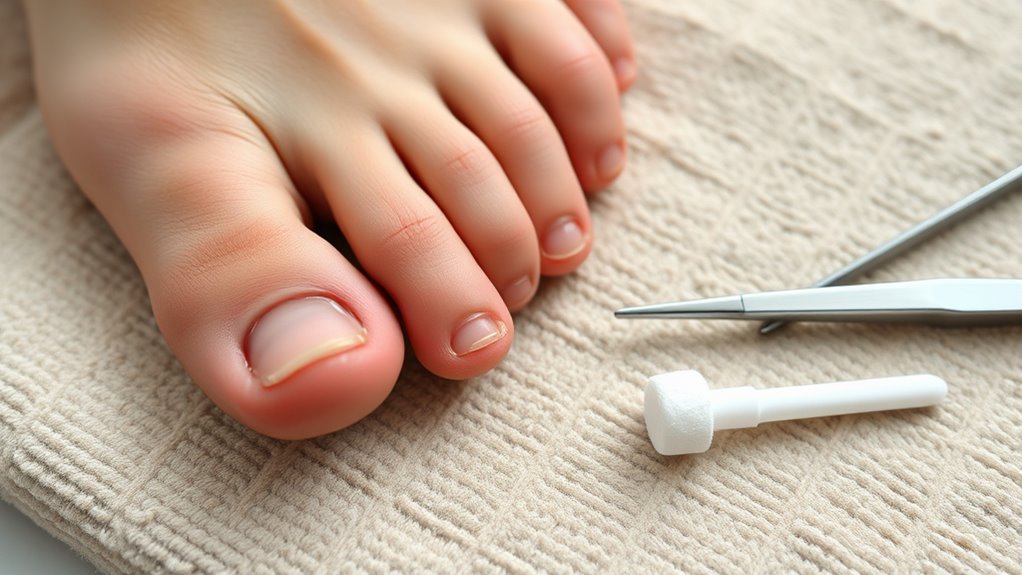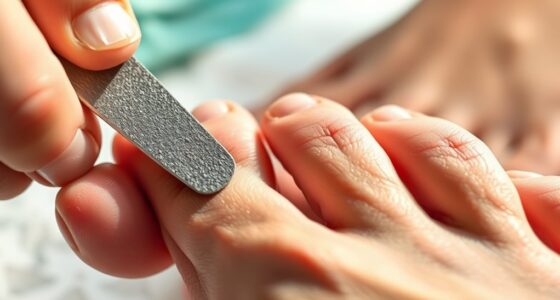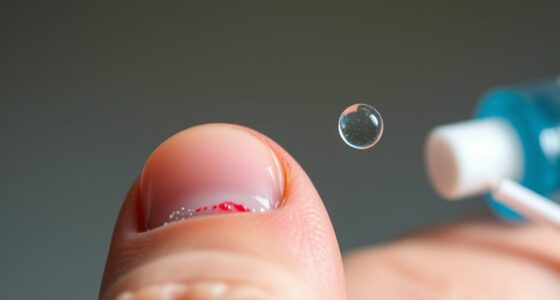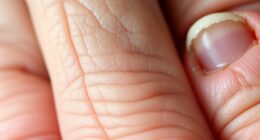To relieve ingrown nail pain at home, keep your feet clean and dry, and soak them in warm water with Epsom salt several times daily to reduce swelling. Gently lift the nail edge with sterilized tools and carefully place a small piece of cotton or floss underneath to help guide growth away from the skin. Apply an antibiotic ointment and cover with a clean bandage. If discomfort persists or worsens, learn more about safe steps to prevent infections and promote healing.
Key Takeaways
- Soak the affected toe in warm water with Epsom salt multiple times daily to reduce inflammation and soften the nail.
- Gently lift the nail edge using sterilized tools and place cotton or dental floss beneath to relieve pressure and encourage proper growth.
- Keep the area clean, dry, and covered with a sterile bandage to prevent infection and promote healing.
- Apply antibiotic ointment after soaking and lifting to reduce bacteria and support recovery.
- Seek medical attention if pain, swelling, or signs of infection worsen or persist despite home care.

If you’re dealing with an ingrown nail, relief can often be within reach with the right approach. The key is to focus on proper nail trimming and maintaining good foot hygiene. When trimming your nails, make sure to cut straight across rather than rounding the edges. Cutting nails too short or shaping them into curves can encourage the nail to grow into the skin, worsening the ingrown condition. Always use clean, sharp tools, and avoid tearing or ripping the nail, which can cause additional trauma and increase inflammation. Proper nail trimming is essential because it reduces pressure on the surrounding skin and prevents the nail from digging into the flesh.
Trim nails straight across to prevent ingrown toenails and promote healthy growth.
Foot hygiene also plays a critical role in managing an ingrown nail. Wash your feet daily with warm water and mild soap to keep the area clean and free from bacteria that could cause infection. Dry your feet thoroughly, especially between the toes, as dampness can lead to bacterial growth. Wearing breathable footwear made of natural materials allows air circulation, helping to keep your feet dry and reduce irritation. Avoid tight shoes or high heels that squeeze the toes together, as this can push the nail into the skin more forcefully. If you notice any redness, swelling, or pus around the affected nail, it’s a sign that infection may be developing, and you should address it promptly to prevent complications.
To ease discomfort, soaking your foot in warm water several times a day can soften the skin and reduce swelling. Adding Epsom salt to the soak can help soothe inflammation. After soaking, gently lift the edge of the ingrown nail using a clean, sterilized implement—such as a small piece of cotton or dental floss—placed gently under the nail to encourage proper growth. Be cautious and gentle to avoid causing further injury or infection. Applying an antibiotic ointment and covering the area with a clean bandage can provide additional protection. Additionally, understanding the importance of proper foot hygiene can significantly prevent future occurrences.
While at-home remedies can be effective for minor cases, persistent pain, significant swelling, or signs of infection mean it’s time to see a healthcare professional. They can safely remove or lift the nail, prescribe antibiotics if needed, and provide guidance on avoiding future problems. Remember, preventing ingrown nails starts with good foot hygiene and careful nail trimming habits. By staying vigilant and attentive to your foot health, you can reduce the risk of ingrowing nails and manage discomfort early on.
Frequently Asked Questions
When Should I See a Doctor for an Ingrown Nail?
You should see a doctor if your ingrown nail’s symptom severity worsens or if you notice signs of infection, like increased redness, swelling, pus, or persistent pain. Don’t delay seeking medical help if pain becomes unbearable, if the area is spreading, or if you have underlying health conditions like diabetes. Prompt professional care can prevent complications and guarantee proper treatment, especially when at-home remedies no longer suffice.
Are There Specific Shoes That Prevent Ingrown Nails?
Choosing the right footwear can help prevent ingrown nails. Look for shoes with appropriate footwear that fit well, providing enough space for your toes to move freely. Avoid tight or narrow shoe selection, especially around the toe area, as it puts pressure on your nails. Opt for shoes with a wide toe box and good arch support. Making smart footwear choices can considerably reduce your risk of developing painful ingrown nails.
Can Ingrown Nails Cause Permanent Damage?
Did you know that untreated ingrown nails can cause lasting damage? If you ignore the pain, it might lead to permanent issues like abnormal nail growth or nerve damage. Applying gentle care helps prevent complications. You should seek medical attention if symptoms worsen, as persistent ingrown nails can harm surrounding tissue and nerve endings, risking long-term damage. Proper treatment now keeps your nails healthy and prevents permanent problems.
What Home Remedies Are Unsafe for Ingrown Nails?
Using sharp tools or harsh chemicals on your ingrown nail is unsafe at home. You might think you can dig out the nail or use strong chemicals to dissolve it, but this can cause infections, severe pain, or permanent damage. Instead, avoid these risky remedies and focus on gentle methods like warm soaks or over-the-counter treatments. When in doubt, consult a healthcare professional for safe care options.
How Long Does It Take to Recover From an Ingrown Nail?
Think of your recovery as a garden slowly blooming. From the moment you start treatment, your nail’s growth guides your healing journey. Typically, it takes a few weeks to a few months for the nail to fully grow out and resolve the discomfort, depending on the severity. Your recovery timeline varies, but patience and proper care nurture healthy nail growth, helping you return to comfort and confidence.
Conclusion
Don’t despair if your toenail troubles persist. With simple, safe, and swift solutions, you can soothe soreness and stop the suffering. Stay consistent, keep clean, and consider these caring cures to combat curling, cutting, and discomfort. Remember, patience and proper prevention prevent painful problems from piling up. Take charge of your toes today—tackle tenderness with tenacity and turn pesky pain into peaceful, pain-free feet. Your journey to joyful, healthy nails begins now!









